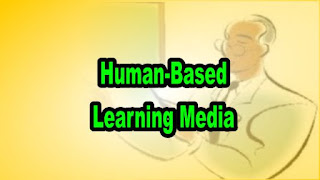Human-Based Learning Media
Many benefits are obtained from this learning media, so learning media can be classified into several groups. Here are the kinds of learning media:
Human-Based Learning Media
Human-based learning media is the oldest media used to send and communicate messages or information (Arsyad Azhar, 2011). Human-based learning media are usually found when in the classroom, by way of face-to-face meetings between educators and students. Human-based learning media have many benefits, especially if our aim as a teacher is to change attitudes or want to be directly involved with monitoring student learning. For example, human media can influence the learning process through activities to gain new experiences from new situations that occur around the learning environment. Human instructors or teachers or educators as media who have the ability to know or understand something without thinking or learning can feel the needs of each student, and provide learning experiences that will help achieve the learning objectives.
Human-based learning media has 2 effective learning techniques. Namely learning techniques that are faced with problems and learning techniques by way of asking Socratic style. The purpose of learning techniques that are faced with problems is that students are given a problem or existing problem then the problem can be solved by it. The steps in designing this type of learning are as follows: (Arsyad Azhar, 2011, p.83)
- Formulate the problem in a related or relevant way
- Identifying knowledge and skills related to solving problems. Use textbooks and lectures as a source for presenting knowledge.
- Teach why knowledge is important and how it can be applied to problem solving.
- Guide the activities of a student.
While the Socratic learning technique means to use or ask a variety of questions both from the teacher and from students to the teacher, so that the technique has the benefit of being able to encourage students to think through cognitive inquiry. The steps of the Socratic learning technique are as follows: (Meaningful Assessment, 2002).
1) Prepare a line of questions that will be asked to students.
2) The teacher gives questions to students and is expected to find the right answers.
3) Teach why knowledge is important and how it can be applied to problem solving.
4) Guide the activities of a student.
One important factor in learning with human-based media is interactive lesson design. With humans as the main actors in the learning process, the opportunity for interaction is increasingly wide open. In addition, interactive learning encourages student participation and if used properly can enhance learning outcomes and increase knowledge (Arsyad Azhar, 2011). The following are some types of interactive learning:
- Participatory learning is learning by expressing the opinions of all students. Then the teacher groups, evaluates, and discusses the results of shared opinions with students.
- Role playing learning is by means of role playing by students who volunteer and are given stages then important information items are discussed and concluded.
- Team quiz learning is started by announcing to students that there will be a quiz when the lesson ends. Students are divided into groups and compete to collect numbers based on the number of correct answers. Then each team will be asked a question, with that per team will give the best answer.
- Cooperative learning is by forming a team or group that can be responsible for teaching each other specific knowledge or skills.
- Structured debate that is by outlining the issues that have been given by the teacher. Then each team expressed their views related to the issue. After that the teacher discusses the issue being debated.
- 99-second learning, namely by way of directing students to discuss information briefly according to a predetermined time (Arsyad Azhar, 2011, p. 87-88).
Strengths and Weaknesses of Human-Based Learning Media Strengths
- Can help students to connect new knowledge with prior knowledge.
- Can help students to shape characters and personalities better.
- Can help students to examine the similarities and differences of problems and new experiences with previous ones.
Deficiency
- Make students get bored more quickly.
- Submission of subject matter becomes ineffective and conducive when there are too many audiences.
- Submission of subject matter will be less understood by students if the sound is not heard.
